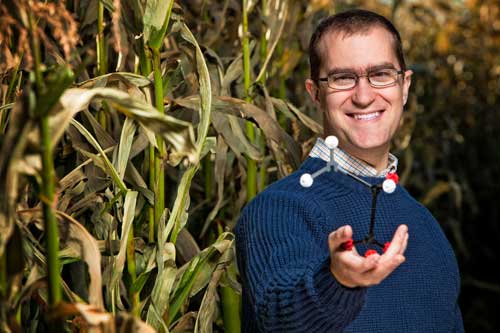The business of research at the University of Lethbridge keeps growing and, like any other business, needs people and resources to keep the wheels of innovation turning.
Recent rankings which place the U of L's research efforts at the top and near to the top of influential listings of Canadian research universities, show and tell the U of L's research achievements based on numbers.
But there are more than numbers to this success – there are people who, through very diverse projects, demonstrate the unique ways in which the U of L is, as described by the editors at Maclean's magazine, "…Alberta's rising research star."

Recent funding announcements by the Canada Foundation for Innovation and the Canada Research Chair program have brought to the U of L new or renewed funding in excess of $2.4 million. Many of the funding awards are eligible for matching funds, or can be used to lever additional resources which further advance the U of L's research agenda. As more research funding is confirmed, other U of L researchers will be profiled.
Dr. Andrew Iwaniuk
Dr. Andrew Iwaniuk, a researcher at the Canadian Centre for Behavioural Neuroscience who studies the development of avian brains, will use his Canada Foundation for Innovation funding to purchase a sophisticated slide scanner, microscope and related equipment which will allow his research team to create what are known as virtual slides. ($131,000)
From these virtual slides, he will be able to perform a myriad of measurements and analyses to better understand how the brain is organized and how brain damage arising from exposure to environmental toxins occurs in various bird species. In addition to these direct research uses, Iwaniuk has amassed the largest collection of bird brains in the world, which at present includes over 500 specimens representing more than 150 different species from North America, Australia, Africa, Australia and Europe.
One of his aims over the next several years will be to digitize this entire brain collection and make it available to researchers, educators and students worldwide. By creating a virtual museum within which anyone will be able to look at virtual slides and photos of entire brains, researchers from around the world can more readily collaborate and provide information to educators and the general public on how the brain has evolved among birds.
Dr. Louise Barrett
Dr. Louise Barrett studies the social processes and behaviour of people and primates. Her research will determine how social functioning can be improved by examining connections between social environment and the development of interpersonal skills. Barrett, a Canada Research Chair in Cognition, Evolution and Behaviour, is aiming to discover how the actions of others help shape our social worlds – and therefore our psychology. She's doing so by studying the social behaviour and cognition of both humans and our primate cousins in Canada and South Africa. ($1.4 million/seven years)
Primates are known for their intense sociability, which is thought to have shaped the ways in which we think about the world. Research in this field has usually considered that social information is processed solely inside the head. However, Barrett is emphasizing how physical or bodily engagement with the world – and with other individuals – can and should be recognized as part of our psychology. In that respect, cognitive processes can be considered as both visible and social, and not just invisible and private.
In addition, Barrett is studying how various types of 'social niches' help shape psychology from infancy to adulthood, and how language and culture influence generate differences between humans and primates.
By challenging long-held beliefs about the way primates think and socialize, Barrett's work is paving the way for new forms of psychology that could improve people's social experiences by increasing the understanding of the social skills they need in a complex society.
Dr. Stacey Wetmore
Dr. Stacey Wetmore, Canada Research Chair in Computational Chemistry was recently renewed as a Tier 2 Canada Research Chair ($500,000/five years).
Wetmore uses computers to explore the reactions between DNA and various harmful chemicals in order to understand how DNA gets damaged. And in order to clarify how nature affects repairs, she studies how enzymes in our body repair our DNA by chemically removing the damaged sections of DNA.
Computers help Wetmore examine molecules that are difficult or impossible to learn about using traditional experiments. For example, it is difficult to study some molecules experimentally because they live for such a short time; using computers, however, speeds up the process so she can investigate their properties thoroughly.
Computer simulations are the tool of choice that not only allow Wetmore to study molecules quickly and cheaply but also allow her to study chemically modified DNA pieces that have applications as drugs or tools for biotechnology.
Drs. Paul Hazendonk, Michael Gerken and Paul Hayes
The trio of chemistry researchers has received substantial funding from the Canada Foundation for Innovation ($400,000) to purchase a significantly more powerful NMR system, which will allow the researchers – who envision collaboration with researchers working on wide-ranging projects from the oil and gas, agriculture and pharmaceutical industries – to more accurately measure the structure of various solid and liquid compounds down to the atomic level of accuracy.
Their research – and the current NMR facility, which is also in the process of receiving a significant upgrade – is already attracting worldwide attention. With the addition of the new equipment, they expect to expand their programs, ability to work with graduate and undergraduate students, and enhance their relationships with a wide variety of collaborators. The facility is expected to take about a year to fully commission.
This story first appeared in the November 2012 issue of the Legend. To view the full issue in a flipbook format, follow this link.
